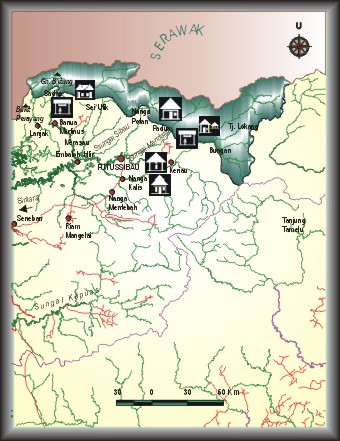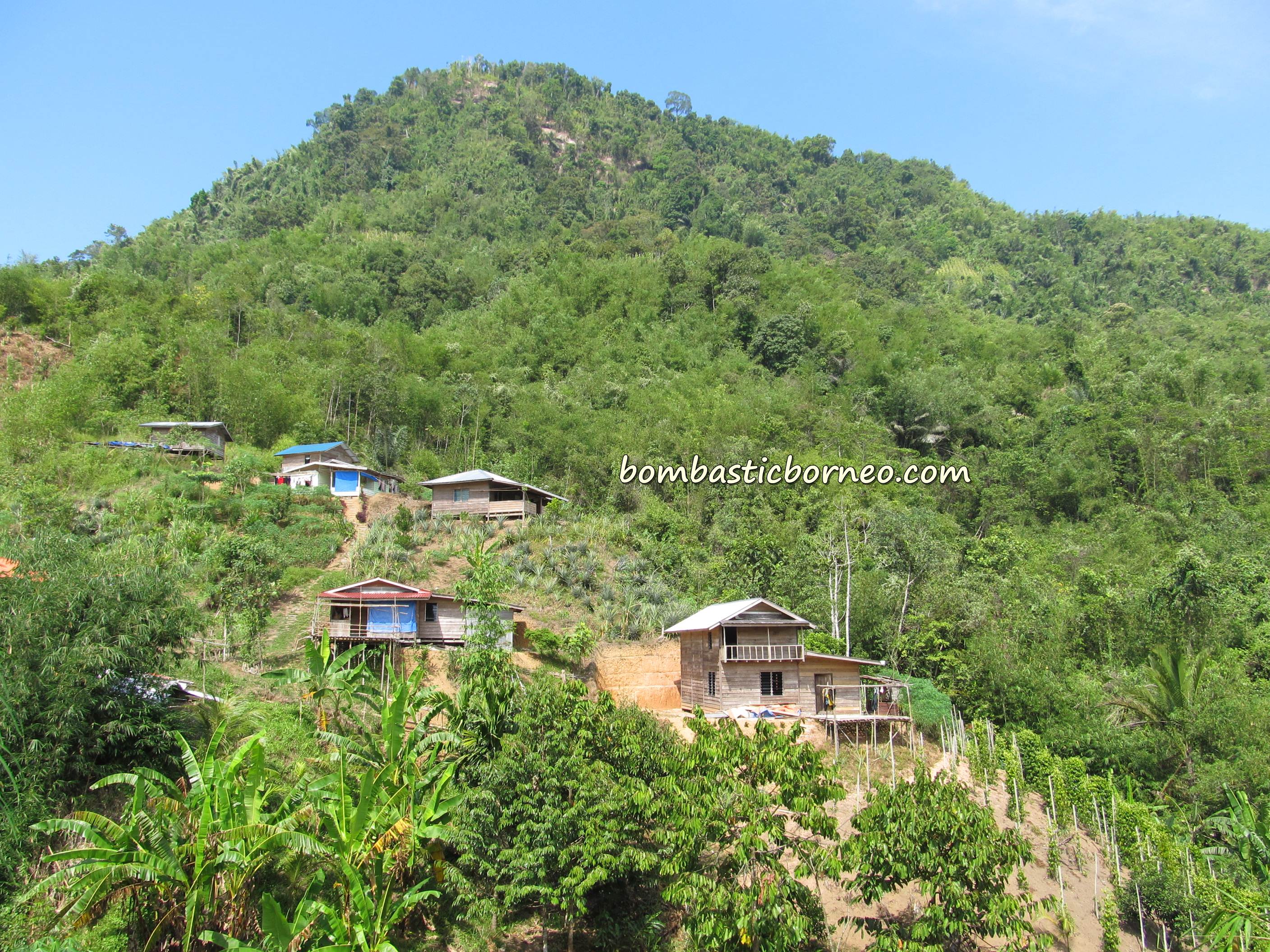Location : Regency of Kapuas Hulu
(Province of West Kalimantan)
Established : 1995
Designated : Minister of Forestry, SK.No.467/Kpts-II/95
Total area : 8,000 km²
Temperature : 21° - 28°C
Rainfall : 2,800 - 5,500 mm/year
Altitude : 150 - 2,000 m asl.
Coordinates : 1°13′15″N 113°21′11″E /
1.22083°N 113.35306°E / 1.22083; 113.35306
Best time of year to visit : September to December.
Introduction
Topographically, Betung Kerihun National Park is hilly. The Muller range which connects Mount Betung and Mount Kerihun also forms the border between Indonesia and Serawak, Malaysia. The Park has been proposed as a “Trans-border Rainforest Heritage of Borneo” together with Lanjak Entimau Wildlife Sanctuary in Sarawak.
Small streams flow from the foothills of the Muller Mountains to form the Kapuas, Sibau, Mendalam, Bungan and Embaloh Watersheds. The Park can only be reached via these rivers.
The Park has eight types of forest ecosystem such as lowland forest, old secondary forest, Dipterocarpus, sub-montane and montane forest, with a high value plant diversity of 1,216 species consisting of 418 genera and 110 families (75% endemic to Kalimantan). Fourteen species are “new records” in Indonesia, like Musa lawitiensis, Neouvaria acuminatissima, Castanopsis inermis, Lithocarpus philippinensis, Chisocheton cauliflorus, Syzygium spicata, and Shorea peltata; and 13 species of palm which are “new records” in Kalimantan, such as Pinanga bifidovariegata and Ixora sp.
There are some 48 species of mammal, including seven primate species such as the maroon leaf monkey (Presbytis rubicunda rubicunda), orang utan (Pongo satyrus), Mueller’s Bornean grey gibbon (Hylobates muelleri), white-fronted leaf monkey (Presbytis frontata frontata), and banded leaf monkey (P. femoralis chrysomelas); 301 species of bird, 51 species of amphibian, 52 species of reptile, 170 species of insect, and 112 species of fish.
The dominant and most commonly seen animals are orang utan (Pongo satyrus), sambar deer (Cervus unicolor brookei), western tarsier (Tarsius bancanus borneanus), Mueller’s Bornean grey gibbon (Hylobates muelleri), maroon leaf monkey (Presbytis rubicunda rubicunda), sun bear (Helarctos malayanus euryspilus), hairy-nosed otter (Lutra sumatrana), and larger Malay mouse deer (Tragulus napu borneanus).
The most distinct species of bird in this Park are the wreathed hornbill (Aceros undulatus) and the helmeted hornbill (Rhinoplax vigil) which is the mascot of West Kalimantan.
The potentially vast biodiversity riches of the Park pose a challenge to researchers to reveal them. But the Park also has several other attractions such as beautiful vistas over the forest crown which seems to go on forever; crystal-clear water flowing from waterfalls on the hilltops; birdcalls and the screeches and cries of various animals.
As with other inland people throughout much of Kalimantan, most of the people living around the Park are Dayak. Here, they belong to the Dayak Iban, Dayak Taman, and Dayak Bukat tribes. Many people are still adorned with tattoos in typical and very distinctive patterns.
Activities
The Muller Range: This forms part of the national border. Mt. Kerihun and Mt. Betung are good places for climbing.
Tekelan, Sibau, Mendalam, Embaloh, Kanyau rivers: Kayaking/canoeing, observing animals and plants, and cultural tourism.
Riam Lapan and Riam Matahari: Hardy souls can test their whitewater rafting skills on numerous rapids, rated at class III-IV in difficulty, climaxing at class V in Riam Matahari.
Sedik, Batang Pilung and Jaan rivers: Waterfalls, observing animals and plants, and cultural tourism.
Tanjung Lokang: Located in the western part of the Park, there are steep slopes and limestone caves suitable for caving and also sites of cultural interest.
Getting there
Pontianak-Putussibau by four wheel drive, about 18 hours; or by small plane (Cessna), about 2.5 hours. Then, from Putussibau along the Kapuas, Sibau and Mendalam rivers by semi-longboat, about 5 hours, or alternatively, from Putussibau up the Kapuas and Embaloh Hulu rivers by speed boat, about 3 hours; and then up the Embaloh Hulu river by semi-longboat, about 9 hours.
Contacts
Address : Jl. Kapten Pierre Tendean, Kompleks KODIM 1206, Putussibau – Kalbar – 78711
Tel /Fax : (+62)567-21935
Email : tn_betungkerihun@yahoo.com
Source : http://www.dephut.go.id/uploads/INFORMASI/TN%20INDO-ENGLISH/betung_NP.htm











Hi,
I am karst naturalist from Sarawak and interested to survey limestone outcrop in Betung-Kerihun N.P. I want to ask about the cost needed for reaching Tanjung Lokang from Pontianak.
Best,
Fendie
Hi ME, I’ve just called up and spoken to the staff at the Indo Consulate in Kuching. He said the the CIQ at Lubuk Antu/Badau will only be officially opened later this year. So until that happens you are advised to go to Ponti (by air/land) and make your ground arrangement from there. This will of course be more expensive compared to, when the CIQ at LA opens, via LA if you are not in a hurry. Do keep in touch and let us know of your plans. We might be interested to tag along.